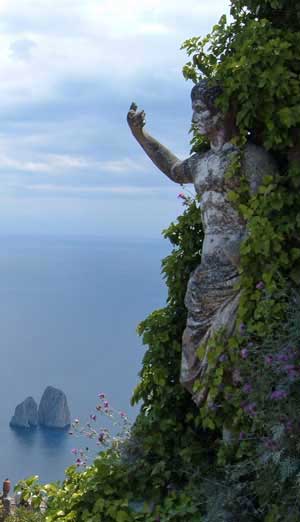
Focus on Capri
1. Introduction
2. Best of Capri
3. Capri town
4. Anacapri
5. Capri hotels
6. Anacapri hotels
7. Hotel ‘A Paziella
8. Hotel Weber Ambassador
About Anacapri
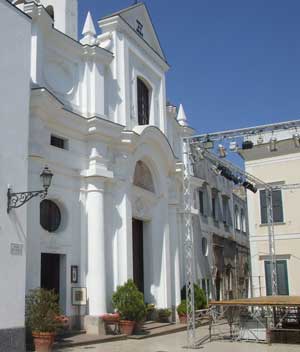
The island of Capri has two principal towns, Capri town and Anacapri. Anacapri is on a high plateau above Capri town, with the two towns linked by a zigzag road down the cliffs. Before the road was constructed in the late nineteenth century, Anacapri’s only connection with the outside world was via a flight of steps called the Scala Fenicia (Phoenician Steps), which still leads steeply down the mountainside to Marina Grande, the island’s port. Axel Munthe, resident in Anacapri in the late nineteenth and early twentieth century (whose memoirs are a good preparatory read), wrote that he encountered Anacapri villagers who had never been to Capri, and vice versa. The two settlements are historic rivals and even nowadays they have completely different atmospheres and attractions. Anacapri is peaceful, residential, and still feels like a village, while Capri is expensive and full of smart hotels.
Anacapri is spread below the slopes of Monte Solaro, the island’s peak. It is a pretty whitewashed little town with picturesque alleys and pedestrian lanes as well as a few vehicle routes heading out towards the more far-flung corners of this western end of the island. There are several affordable places to stay in Anacapri and in the surrounding countryside, and there are also more ‘normal’ shops than in Capri town, selling everyday necessities and foodstuffs.
While Anacapri is not a ‘resort’ town like smart little Capri, it is still on the tourist trail, as daytrippers – including tour groups – are bussed up here to visit Villa San Michele or to take the chairlift. There are a couple of streets busy with souvenir shops. Away from these lanes at peak times, though, it is easy to find a tranquil, ‘villagey’ atmosphere.
Things to see in Anacapri
Anacapri’s biggest tourist attraction is the Villa San Michele. This picturesque building, perched on the mountainside looking down over the lower half of Capri, was built by the Swedish doctor and writer Axel Munthe (1857-1949). His book about the villa, Capri and his life in general is a colourful introduction to Capri, and if you’ve read it you won’t want to miss touring his home and admiring his collection of antiquities (see our Capri page for more abut his book The Story of San Michele). The villa is open daily 9am-6pm in summer; with earlier closing in winter. There is an entrance charge. In the summer the villa hosts a season of outdoor evening concerts.
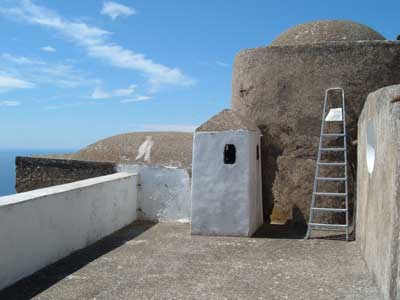
In the heart of the settlement, the Chiesa di San Michele is a small but interesting church, with a renowned eighteenth-century majolica (painted ceramic) floor. This features lovely pastoral scenes, including Adam and Eve. The church is open from 9am-7pm, and there is a small charge for admission. Summer concerts are held outside in Piazza San Nicola.
The Casa Rossa or ‘Red House’ was built for an American colonel from New Orleans who lived here at the end of the nineteenth century. The local comune has opened this eccentric building, painted bold Pompeian red, to the public. The small museum exhibits a collection of paintings of the island. The house is located on Via Orlandi, and is open May-October, Tuesday-Sunday. Note that the building closes for most of the afternoon.
There is a little tourist information office in Anacapri on Via Orlandi. Unusually for Italy, the local tourist authority seems to understand and encourage walking; you should be able to pick up maps and directions here for the walks we suggest below.
Excursions around Anacapri
Monte Solaro
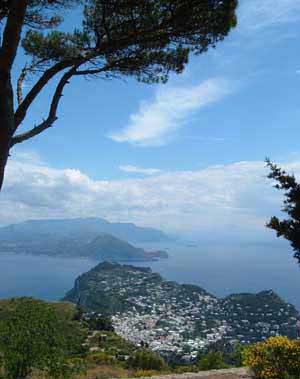
Capri’s highest point can be reached quickly and easily from Anacapri by taking the popular chairlift (seggiovia). Being cowardly, we tried this once, swinging with our legs dangling above the hillside, and swore to rely on our feet in future. The walk is pleasant and not very long: if it’s a hot day or you just don’t fancy the uphill walk, take the chairlift and then descend on foot. At the summit there is a cafe with panoramic terraces. When the weather is clear the views are beautiful.
To climb the hill on foot, start on Via Capodimonte, which connects the Villa San Michele with Piazza Vittoria, and turn up Via Monte Solaro, a pedestrian path which heads up the mountain slopes. Towards the top you reach a grassy pass. Before continuing uphill to the summit, stroll along the pretty footpath to the left, which leads past a villa once belonging to writer Compton Mackenzie and along to the little hermitage chapel of Santa Maria a Cetrella – a curious and picturesque place to visit, perched on the brink of the cliffs above Capri town. Continuing up to the summit of Monte Solaro (589m above sea level), you’ll find the cafe at the top of the hill is usually busy with chairlift arrivals, but the surrounding slopes are much more peaceful and ideal for picnics. The mountainside, speckled with flowers, offers a real contrast to the busier corners of Capri.
Grotta Azzurra
The ‘Blue Cave’ is Capri’s most famous attraction. It is located at the western, Anacapri end of the island, although most tourists approach by boat from Marina Grande. It is a large cave with a small entrance at water level – the light refracting through the sea illuminates the cave with an eerie blue light. It became a popular tourist destination in the nineteenth century, although Roman ruins found here show that it was also visited by the pleasure-seeking Romans. The Grotta Azzurra can be reached from Anacapri by bus. When you reach the shore close to the cave, you transfer to a small rowing boat. There’s an admission fee for the cave (free for EU citizens under 18 and over 65) and also a charge for the rowing boat. The men who row the little boats are notorious for pressing for additional tips; these are optional. Entrance to the cave is through the small opening at sea level – you will need to duck. When the sea is rough the cave isn’t accessible, so before you set off it’s a good idea to check (through your hotel or a tourist information office) if it is open.
Villa Damecuta
Villa Damecuta is one of Capri’s archaeological sites, located right alongside the island’s little heliport on the north-western corner of the island. It’s one of several Roman villas on the island which would have belonged to the Emperor Tiberius, though there is a lot less to see here than at Villa Jovis, near Capri town. The site is open during daylight hours and entrance is free. The spot is high above the sea and has good views over the coastline, dotted with little forts. It is a pleasant walk from Anacapri, mostly along narrow lanes and steps. The bus to the Grotta Azzurra stops nearby, giving you the choice of an easier journey, or of extending your outing – ask the driver to let you off at the right place.
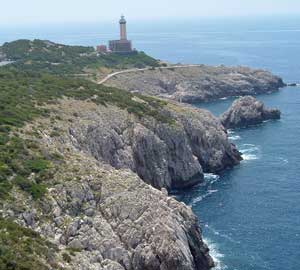
Faro
The Faro, Capri’s lighthouse, is on a rocky headland is called Punta Carena, and is a popular destination for swimmers. It can be reached by bus from Anacapri, or on foot, and it is a picturesque spot offering sea views and some walking. Down on the rocks there is a bathing establishment with a cafe. A carefully laid-out footpath, the Via dei Fortini (Way of the Little Forts), connects the various historic fortifications dotted along the western shore of Capri, between the Grotta Azzurra and Punta Carena. The route takes around 3 hours; when we walked part of it we found that the expensive paving and information signs (EU funds perhaps) were already becoming overgrown, and that the fort we visited was plainly frequented only by night-time couples. Still, the views are attractive and the council may have improved maintenance of the footpath.
Our top Anacapri tip
When catching the bus to Capri: Although there is a clearly defined queueing system at the main bus stop in Anacapri, you may have to wait some time to squeeze onto one of the small island buses. Walk up the street away from Capri town (towards the bus’s origin) and wait at the next stop along – or even the stop before that. It’s only a short walk and you should fit on the first bus that turns up.
Accommodation
There is more affordable accommodation in Anacapri than in Capri town, and it makes a more peaceful alternative place to stay.
> Our recommended Anacapri hotels and B&Bs (including some good-value options)
On this site
Anacapri hotels – our selection
Hotel ‘A Paziella, Capri town – our review
Hotel Weber Ambassador, Marina Piccola – our review
Useful external links